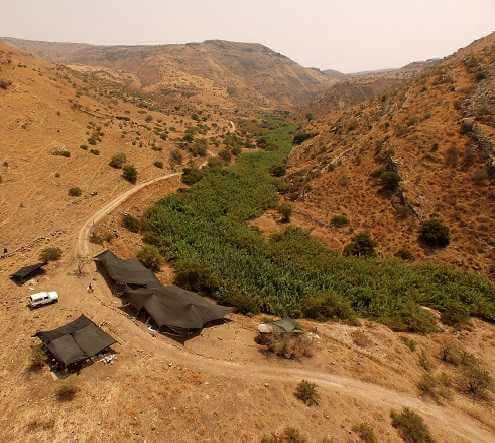The picture of the findings emerging from the excavations on the site is like a close-up picture of one of the most significant road interpretations in the history of human society

Archaeologists from the Hebrew University of Jerusalem discovered in Nahal Ein Gev a prehistoric settlement from the late Natufian culture (about 12,000 years ago), one of the last settlements of the Paleolithic period - the Early Stone Age. The discovery of the prehistoric settlement in the Jordan Valley sheds light on the important transition in human history to agriculture and permanent settlement.
The Stone Age is the earliest in the history of human development, and at the end of it, agricultural settlement developed, which occurred at different times in different geographical areas.
The site, known as NEG II, is located on a terrace in Nahal Ein Gev, which flows west from the slopes of the Golan to the Sea of Galilee. In the excavations conducted there, a wealth of finds were discovered, including artefacts, bone tools, flint tools, as well as a settlement that covers an area of approximately 1200 square meters, which includes the remains of large buildings with stone foundations that indicate a significant investment in permanent settlement.
In an article published in the journal PLOS ONE, the researchers explained that the Natopian culture that existed in the Jordan Valley constituted a cultural entity that bridged the lifestyles of hunter-gatherers that characterized human societies in the Paleolithic period and the societies of settled farmers in the Neolithic period - the New Stone Age.
"The characterization of the population in the transition between the periods is essential for understanding the socio-economic processes that influenced the important transition in human history to agriculture and permanent settlement," explains Dr. Lior Grossman from the Institute of Archeology at the Hebrew University, who led the excavations.
All along the Levant, from the Negev and Sinai in the south to Lebanon and Syria in the north, settlements from the Natufian culture were discovered. Some of the settlements were established as temporary camps of nomadic hunter-gatherer groups, and some, mainly at the beginning of the period (about 15,000 years ago), were permanent settlements whose area reached about 1000 square meters. But the settlement discovered in Ein Gav is distinctly different from other settlements discovered in the area from the same period.
"The size of the settlement and the extensive finds that were discovered indicate the settlement of a very large community compared to the settlements from the end of the Natopian culture that have been discovered so far in the Mediterranean region," says Dr. Grossman.
The settlement in NEG II occurred in the midst of a global climatic event known as the Younger Dryas (approximately 11,600-12,900 years BCE), in which temperatures dropped suddenly and significantly. The popular opinion was that the climatic changes influenced the Natopian culture to adopt a lifestyle of mobility, but the site at Ein-Gev reveals a different settlement pattern.
"From the findings of the excavations it appears that the excavated buildings represent at least four consecutive phases, with architectural planning and the use of unique construction methods. The uniformity of the flint tools and their production technique point to the settlement of the site by the same cultural entity. "Also, the remains of the animals that were found show the diet of the settlers who settled on the site, the patterns of exploitation of the environment, and the intensity of the settlement, which characterizes a permanent settlement," explains Dr. Grossman.
The reasons for the permanent settlement in the Jordan Valley during the late Natufian period may be relative climatic stability in this area, an increase in grain yield and favorable conditions for cultivation, which were essential elements towards the creation of agriculture in the southern Levant.
Excavations in NEG II yielded findings that characterize the Natopian culture at the end of the Early Stone Age and also the beginning of the New Stone Age. The combination of the elements reflects the fundamental changes that human societies underwent in ancient times from mobile groups of hunter-gatherers, as they existed until then from the dawn of human history, to agricultural societies that lived in permanent settlements, for all the cultural consequences that resulted from that transition.

3 תגובות
Of particular interest is the elevation of the ground surface at the site and its relation to the Sea of the Tongue in an earlier period. It seems to me that the surface level of the Tongue Lake was around -160-170-. Are there any markers in the vicinity of the level of the surface of the tongue?
The dating process is detailed in the PlosOne article. (carbon dating of charred samples)
Thanks for the article.
By the way, what dating method did you use?